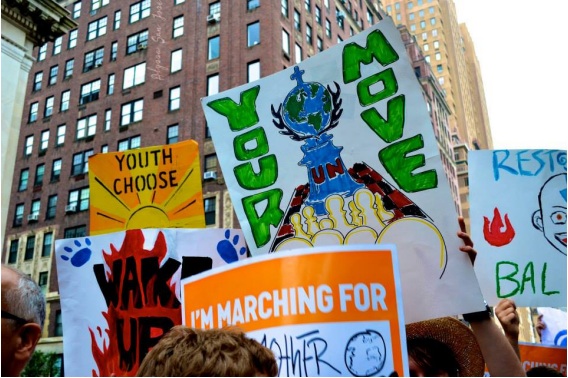To say that the future of the human species is at stake in the current moment is neither hyperbole nor alarmism.
Hopefully, by the COP21 climate negotiations in Paris this week, everyone will have brushed up on their climate change facts and be part of the conversation. While I work on solutions (and communicating about solutions) for a living, it’s important to start with a foundation of clarity on what the problems are—and what, in fact, is at stake.
One of the best places to start is here, in Bill McKibben’s landmark Rolling Stone article from 2012. McKibben writes:
“When we think about global warming at all, the arguments tend to be ideological, theological and economic. But to grasp the seriousness of our predicament, you just need to do a little math. For the past year, an easy and powerful bit of arithmetical analysis first published by financial analysts in the U.K. has been making the rounds of environmental conferences and journals, but it hasn’t yet broken through to the larger public. This analysis upends most of the conventional political thinking about climate change. And it allows us to understand our precarious—our almost-but-not-quite-finally hopeless—position with three simple numbers.”
1. Two Degrees Celsius.
One of the few things that the international community has agreed upon is that two degrees Celsius is the absolute highest that global temperatures can rise before complete catastrophes beyond our comprehension are likely to occur. Many argue that two degrees is actually too high, given that global temperatures have already risen 0.8 degrees; however, world leaders have agreed to two in the interest of feasibility. The nice thing about this figure, at least, is that it’s easy to understand and communicate.
2. 565 Gigatons.
A gigaton is one billion tons. Scientists’ best estimate of how much carbon we could release into the atmosphere (as of August 2012) and not pass 2 degrees is 565 gigatons.
The bad news: “computer models calculate that even if we stopped increasing CO2 now, the temperature would likely still rise another 0.8 degrees, as previously released carbon continues to overheat the atmosphere. That means we’re already three-quarters of the way to the two-degree target,” says McKibben.
So far, emissions numbers have been climbing at record pace, year-over-year, and stopping emissions now is as unlikely as anything I can think of. We’re hoping that in Paris, global leaders will actually come to a binding agreement to lower emissions at all. McKibben says, “Study after study predicts that carbon emissions will keep growing by roughly three percent a year—and at that rate, we’ll blow through our 565-gigaton allowance in 16 years, around the time today’s preschoolers will be graduating from high school.”
“The new data provide further evidence that the door to a two-degree trajectory is about to close,” said Fatih Birol, the IEA’s chief economist. In fact, he continued, “When I look at this data, the trend is perfectly in line with a temperature increase of about six degrees.” That’s almost 11 degrees Fahrenheit, which would create a planet straight out of science fiction.” A planet warmed by six degrees is almost certainly uninhabitable by humans.
3. 2795 Gigatons.
According to McKibben, this represents, “The amount of carbon already contained in the proven coal and oil and gas reserves of the fossil-fuel companies, and the countries (think Venezuela or Kuwait) that act like fossil-fuel companies. In short, it’s the fossil fuel we’re currently planning to burn. And the key point is that this new number—2,795—is higher than 565. Five times higher.”
This means we have to keep 80 percent of current existing reserves in the ground to stay under two degrees. And this 80 percent is already accounted into the economic value of oil companies, meaning they will do everything thing in their power to keep it in play, and burn it.
~
To say that these three numbers are humbling doesn’t quite capture the gravity, scope and scale of the situation. It’s time to turn all of our attention not only to this almost incomprehensible problem, but also to the myriad solutions that currently exist.
Here’s what we can do right now to get the ball rolling in the right direction:
1. Get informed.
Follow the research. Many news organizations have tremendous reporting done around climate change and all of its facets. Also, major institutions like NASA and the UN have huge amounts of documents, images and statistics available.
2. Get involved.
Earth to Paris is an organization and a movement dedicated to bringing individual voices to world leaders in Paris. The Guardian has started a campaign called Keep It in the Ground.
3. Educate others.
Take these resources and spread the word, every day, via social media and in person. Many people still do not know the basics of what we are facing. Get the info and pass it on.
We need everyone up to speed, paying attention and active, to enact the incredible change that is needed at this eleventh hour.
~
Relephant Read:
Tackling Climate Change: What We Need to Do.
The Buddha on Paris: The Story we need to Remember Now.
~
Author: Erin McMorrow
Editor: Toby Israel
Photo: South Bend Voice/Flickr // Courtesy of Emma Ruffin
~











Read 0 comments and reply